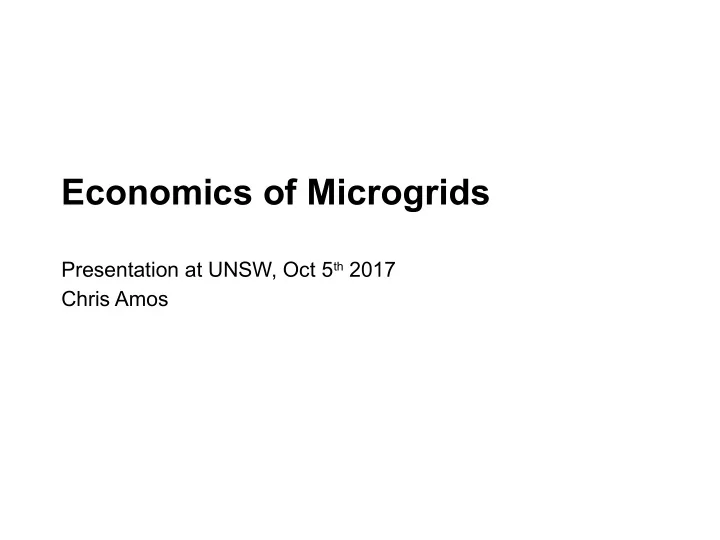

Economics of Microgrids Presentation at UNSW, Oct 5 th 2017 Chris Amos
The Network Today 2
AER regulation Competitive Market Regulated Sector Competition Legislation and National Electricity Rules National Electricity Rules physical energy Generation delivery Transmission e.g. TransGrid $ Energy $ $ supply Pool AER regulation contract Distribution (in NSW) e.g. Ausgrid $ $ NECF Retail Customer Connection Contract Customer National Energy Retail $ Supply Rules Customer contract 3
Assumptions of Regulatory Framework • Framework assumes top to bottom flow • Requires that a retailer is appointed for each connection point • There are exemption guidelines, but they contemplate embedded networks • Network built with redundancy on the basis of peak usage (i.e. those short periods where supply peaks to meet demand peaks) 4
Possible Future 5
Potential Scenario: Large Volumes of Distributed Storage • Hypothetical – What if there was enough distributed storage to supply all electricity demand for 4 or 5 hours? – What if there was enough distributed renewable energy that produced enough electricity to cancel out the need for centralised generation? – Is centralised economic dispatch required? – Is N-1 or N-2 planning required? – Retailer and Network business models? 6
Network cost RRP Load, percentage of maximum $10,000 $1,000 0.01% 100% 100% 7 Some Problems with Relying on Price 0.1% 1.0% $100 10% 20% 40% 60% 80% $10 $1 Jul-99 W Oct-99 Jan-00 S Apr-00 Jul-00 W Oct-00 Jan-01 S Apr-01 Jul-01 W Oct-01 Month Jan-02 S Apr-02 Jul-02 W Oct-02 Jan-03 S Apr-03 Jul-03 W Oct-03 Jan-04 S Apr-04 W Jul-04
Poor Correlation of Pool Price and Network Costs $10,000 Pool price at time of daily peak network cost $1,000 $100 $10 Line of best fit R 2 = 0.29 $1 0.0% 0.1% 1.0% 10.0% 100.0% Daily peak network cost 8
Distribution Regulation: The Challenge of Sunk Costs 9
Graph retrieved on 13 July 2017 from https://kellyandjenny.wordpress.com/2012/01/15/natural-monopoly/ 10
Graphic taken from presentation by Professor Mahesh Bhave, Microgrid Convergence Conference Urban and Campus Microgrids October 25, 2016 Downloaded from: https://www.slideshare.net/MaheshBhave/microgrid-convergence-conference-urban-and-campus-microgrids-october-25-2016-68081058 11
What Used to be Immutable Truths Supply and demand must balance instantaneously as stockpiling • is not economically feasible Central co-ordination is required to keep the grid stable – • frequency control/electrical inertia AC wins due to ease of transforming between voltages to reduce • losses, and DC breaking being difficult Natural barrier to entry • Can’t compete with the cost effectiveness achieved from scale economies – Capital intensive in nature – Consumer behaviour has tended to be economically inelastic, so • does not respond to peak pricing 12
The New Paradigm The economics of scale are falling away • Optimization for capacity, or sizing of generation sources • Optimization of operations • Pro forma cash analysis with assumptions • Demand management, especially in emerging economies 13
Alternate Paradigms / Fractionation / Productisation • DC in the home, savings from not having to do multiple transformations • Niche local electricity solution for specific applications such as pumps • Stand alone rural microgrids • Federation of microgrids with decentralised control 14
Alternate Paradigms / Fractionation / Productisation - 2 • How committed is the government committed to a centralised dispatch market? • Break up the network businesses into microgrids and auction access rights to provide infrastructure and energy supply service – completely dismantle existing market structure • Parallels to teleco break ups, in the 1990s, but does electricity lend itself to ‘productisation’ like mobile devices?? Probably not, but watch this space. 15
Evaluating Market Opportunities • Technical Feasibility – Matching/optimising generation mix, storage & loads – Grid and end user integration – Siting • Economic Feasibility – Identifying Costs and Revenues – Does project exceed current cost of energy for end users? • Financing – Capital Stack and investors’ hurdle rate – Ownership / Management structure – Repayment structure Retrieved from” Brian Farnen, General Counsel and Chief Legal Officer Connecticut Green Bank http://apps.americanbar.org/dch/thedl.cfm?filename=/NR350550/newsletterpubs/BFarnen_Slides-CT_Microgrids.pdf 16
Consideration of Longer Term Liabilities • Battery warranties – Buyer Beware • Consumer expectations of High 9s Reliability – Particularly relevant for stand alone systems • End of Life – Enduring obligations to supply??? – Replacement CAPEX. What about possible AUGEX?? – Cost to dispose of batteries – Environmental risks from battery chemistry? – PV long term performance degradation – Regulation of microgrids likely to develop in the future, what overhead in cost will that bring?? 17
Battery Warranties (from 12 months ago) Information on this slide retrieved from web article by: Ronald Brackels , retrieved 14 June 2017 from https://www.solarquotes.com.au/blog/new-powerwall-warranty/ Mercedes-Benz Energy Storage Home: 80% of nominal capacity • after 8,000 cycles. SimpliPhi PHI3.4 Smart-Tech Battery: 80% of nominal storage • capacity after 10,000 cycles. Enphase AC Battery: 95% of nominal storage capacity after 7,300 • cycles. LG Chem RESU: 80% nominal storage capacity after 2,625 cycles. • GCL E-KwBe: 80% of nominal storage capacity after 2,000 cycles • Tesla Powerwall 1: 60% of nominal storage capacity after 2,368 • cycles 18
Recommend
More recommend